Product Images Midazolam
View Photos of Packaging, Labels & Appearance
- Image10.jpg - Image10
- Image11.jpg - Image11
- Image12.jpg - Image12
- Image13.jpg - Image13
- Image14.jpg - Image14
- Image15.jpg - Image15
- Image16.jpg - Image16
- Image2.jpg - Image2
- Image3.jpg - Image3
- Image4.jpg - Image4
- Image5.jpg - Image5
- Image6.jpg - Image6
- Image7.jpg - Image7
- Image8.jpg - Image8
- Image9.jpg - Image9
- Label1.jpg - Label1
Product Label Images
The following 16 images provide visual information about the product associated with Midazolam NDC 0404-9914 by Henry Schein, Inc., such as packaging, labeling, and the appearance of the drug itself. This resource could be helpful for medical professionals, pharmacists, and patients seeking to verify medication information and ensure they have the correct product.
Image10.jpg - Image10
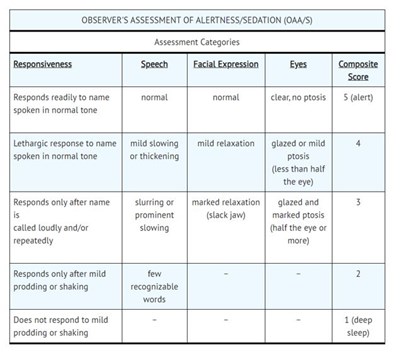
The text describes a tool called OBSERVER'S ASSESSMENT OF ALERTNESS/SEDATION (OAA/S) used to assess an individual's level of alertness or sedation based on their responsiveness, speech, facial expression, and eyes. It lists different assessment categories and scores ranging from 1 (deep sleep) to 5 (alert) based on the individual's response to stimuli such as their name being called, prodding, or shaking. The tool also takes into account factors such as ptosis, slurring, and slowing of speech to determine the individual's level of alertness.*
Image12.jpg - Image12
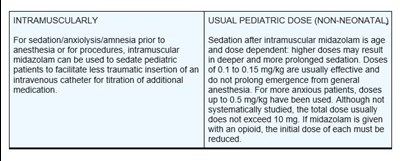
This text provides information on the use of intramuscular midazolam for sedation, anxiolysis, and amnesia in pediatric patients prior to anesthesia or other medical procedures. The pediatric dose of midazolam is dependent on the age of the patient and the desired level of sedation, with doses ranging from 0.1 to 0.5 mg/kg typically used. The total dose of midazolam does not usually exceed 10 mg, and if combined with opioids, the initial dose of each must be reduced.*
Image13.jpg - Image13

This text provides dosing recommendations for midazolam hydrochloride when used for sedation/anxiolysis in pediatric patients. The dose varies based on the age of the patient and the type of procedure. The initial dose should be administered slowly over 2 to 3 minutes, followed by careful titration with small increments until the appropriate level of sedation is reached. The total dose depends on the patient's response, the duration of the procedure, and the use of concomitant medications. Midazolam hydrochloride should be used cautiously in young infants and in patients who have been premedicated with opioid or other sedative agents.*
Image14.jpg - Image14
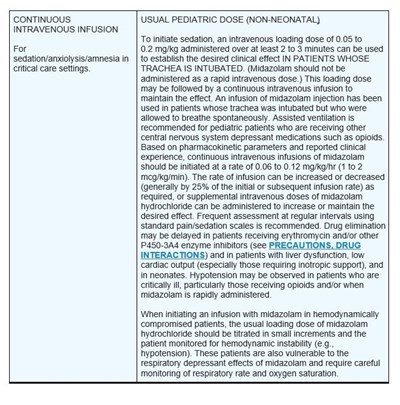
Continuous intravenous infusion of midazolam is a sedation/anxiolysis/amnesia medication used in critical care settings, particularly for patients with an intubated trachea. The dose is administered as a loading dose of 0.05 to 0.2 mg/kg over 2 to 3 minutes, followed by a continuous infusion to maintain the desired effect. The rate of infusion is adjusted as required, and the drug should be closely monitored using pain/sedation scales. However, drug elimination may be delayed in specific cases, such as in patients with iver dysfuncion or low cardiac output. Hypotension and respiratory depressant effects may also occur, and the patient must be carefully monitored.*
Image15.jpg - Image15
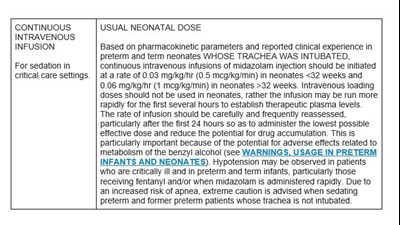
This text provides guidelines for the continuous intravenous infusion of midazolam injection for sedation in critical care settings, specifically for preterm and term neonates whose trachea is intubated. The usual neonatal dose is based on pharmacokinetic parameters and reported clinical experience, with a recommended starting rate of infusion of 0.03 mg/kg/hr for neonates <32 weeks and 0.06 mg/kg/hr for neonates > 32 weeks. Intravenous loading doses should not be used, and the infusion rate should be frequently reassessed to administer the lowest possible effective dose due to the potential for adverse effects related to benzyl alcohol metabolism. Extreme caution is advised when sedating preterm and former preterm patients whose trachea is not intubated.*
Image16.jpg - Image16

Midazolam Injection is a medication that is available in the form of a 50 mg per 10 mL multiple-dose vial. Each mL of injection contains 5 mg of Midazolam. The package factor for this medication is not available. The medication is sold in cartons that contain 10 vials.*
Image2.jpg - Image2

This text provides a brief report on the common local effects after intramuscular injection. It mentions the percentage occurrences of different symptoms such as headache, pain, induration, redness, and muscle stiffness.*
Image3.jpg - Image3
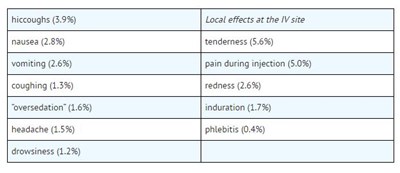
This seems to be a report on the percentage of patients who experienced certain side effects at a particular site during injection. The side effects mentioned are hiccoughs, nausea, tenderness, vomiting, pain during injection, coughing, redness, oversedation, induration, headache, phlebitis, and drowsiness.*
Image4.jpg - Image4
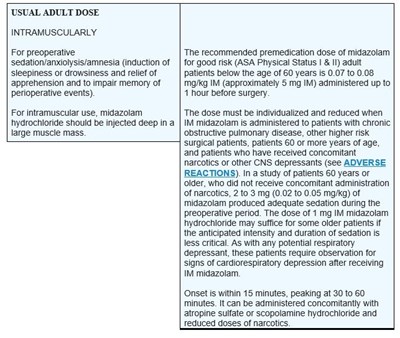
Midazolam hydrochloride is an effective sedative used to induce sleepiness, drowsiness, and relieve anxiety or apprehension before surgery. The recommended premedication dose for good risk adult patients under 60 years of age is 0.07-0.08 mglkg IM (about 5 mg IM) up to an hour before the surgery, but the dosage should be individualized for patients with chronic obstructive pulmonary disease and patients 60 years or older. Also, patients who receive concomitant narcotics or other CNS depressants should have a reduced dosage of midazolam. The onset of midazolam happens within 15 minutes and peaks at 30-60 minutes. It can be given along with atropine sulfate or scopolamine hydrochloride and reduced doses of narcotics. The USUAL ADULT DOSE is for intramuscular use, and the injection should be given deep into a large muscle mass.*
Image5.jpg - Image5
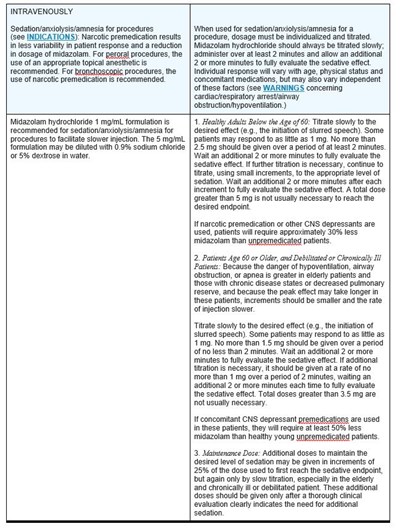
Midazolam hydrochloride is used for sedation, anxiolysis, and amnesia during medical procedures. The dosage must be individualized based on factors such as age, physical status, and concomitant medications. The injection must be given slowly over at least 2 minutes, and an additional 2 or more minutes are required to evaluate the sedative effect. Narcotic premedication may reduce the dosage of midazolam required. For oral procedures, a topical anesthetic is recommended, and for bronchoscopic procedures, narcotic premedication is preferred. A total dose of greater than 5 mg is not usually necessary. Slow titration is essential for debilitated, chronically ill, or elderly patients, and maintenance doses may be given only after a thorough clinical evaluation.*
Image6.jpg - Image6
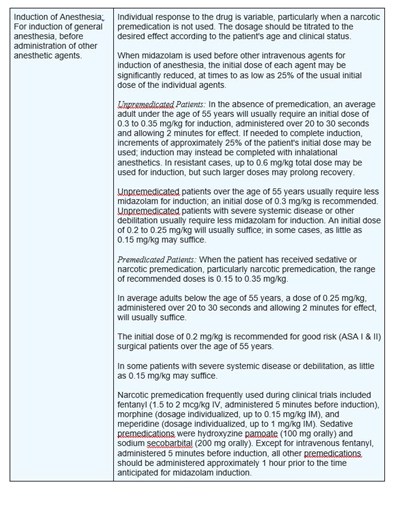
This text provides guidelines for inducing general anesthesia using midazolam in both premedicated and unpremedicated patients. The dosage of midazolam varies based on the age and clinical status of the patient. The text suggests initial dosage of midazolam ranging from 0.15 to 0.35 mg/kg for premedicated patients and 0.3 to 0.35 mg/kg for unpremedicated patients. The dosage may be increased incrementally, and the induction may also be completed with inhalational anesthetics. The text also provides dosage recommendations for patients with severe systemic disease or debilitation. Narcotic premedications such as fentanyl, morphine or meperidine were used during the clinical trials. The recommended timing of administering midazolam induction is after an hour of administering premedications, excluding intravenous fentanyl.*
Image7.jpg - Image7

Injectable midazolam hydrochloride can be used as part of balanced anesthesia and during surgical procedures. It can also be given during the maintenance of anesthesia. Incremental injections of 25% of the induction dose are recommended to be administered in response to signs of lightening of anesthesia. Effective narcotic premedication is especially recommended in such cases.*
Image8.jpg - Image8
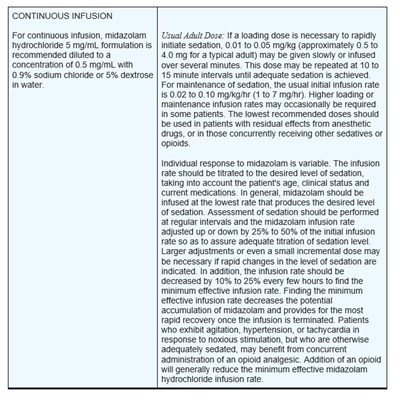
This text provides instructions for the use of midazolam hydrochloride for continuous infusion in adult patients for sedation purposes. The recommended dilution and initial infusion rates are provided, and adjustments to the infusion rate are advised to achieve the desired level of sedation while taking into account factors such as age, clinical status, and medications. The text also suggests that the lowest effective dose be used and that adjustments be made to prevent accumulation of midazolam and to promote rapid recovery once the infusion is stopped. In cases where patients exhibit agitation or tachycardia, the addition of an opioid analgesic may be beneficial.*
Image9.jpg - Image9
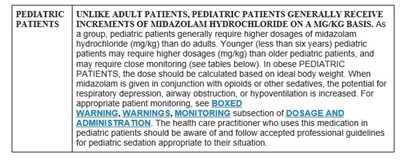
Pediatric patients generally require higher dosages of midazolam hydrochloride (mg/kg) than adults. Younger pediatric patients may require higher dosages than older pediatric patients, and close monitoring may be necessary. In obese pediatric patients, the dose should be based on ideal body weight. Care should be taken when administering midazolam with opioids or other sedatives to avoid respiratory depression, airway obstruction, or hypoventilation. Proper patient monitoring is crucial according to professional guidelines for pediatric sedation. See the boxed warning, warnings, and monitoring subsection of dosage and administration for more information.*
Label1.jpg - Label1
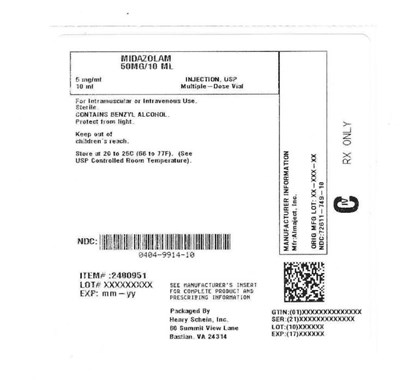
This is a package of 10 milliliter Somg injection solution containing 111idazolam for intravenous or intramuscular use. It comes in a multiple-dose vial and must be stored at 20 to 25 degrees Celsius. The solution contains benzyl alcohol and should be protected from light and kept away from children. The package is manufactured by Henry Schein and has an item number of 2480951. There is a lot number and expiration date provided, but they are not readable due to errors.*
* The product label images have been analyzed using a combination of traditional computing and machine learning techniques. It should be noted that the descriptions provided may not be entirely accurate as they are experimental in nature. Use the information in this page at your own discretion and risk.
